On January 31, 1967, the last section of Interstate 5 from Everett to Tacoma is completed. The section runs about 15 miles from Dearborn Street near Beacon Hill in Seattle to Midway, located at about the Kent-Des Moines Road S.
The Washington State Legislature adopted the plan for a Tacoma-Seattle-Everett "toll superhighway" in 1953, along with a second Lake Washington floating bridge, a bridge across Puget Sound, expansion of Highway 99 to four lanes, widening of the Snoqualmie Pass Highway, and access roads for the Columbia Basin region. Highway planners could not modify many existing routes to the higher-speed and safer limited access highways because of engineering difficulties and the opposition of businesses along the way. But modern expressways consumed two to four times more land than earlier highways had taken.
In 1956, the Washington State Supreme Court declared the toll road idea unconstitutional. This problem was resolved that same year by massive funding from the federal Defense Highways Act.
The state highway department announced in 1952 its plans for the Seattle freeway, which involved cutting a wide swath through the middle of the city including downtown. By 1956, a few began to speak up against the cost of the project including former mayor and city engineer George F. Cotterill and the Chamber of Commerce tollway committee. Public pressure for better highways overcame the opponents however.
Construction consumed 6,600 parcels of land, 4,500 of them in Seattle. Most property owners cooperated in the condemnation proceedings. In 1961, the First Hill Improvement Association complained about the "open ditch" (Dorpat, 96) and tried to get the freeway covered with a park. On June 5, 1961, approximately 100 people marched along the freeway route with a police escort in support of a lid, but the forces in favor of the freeway wanted no delays.
Once Interstate 5 was completed, residents were less willing to acquiesce to plans for a network of similar highways through city neighborhoods. The R. H. Thomson Expressway through the Central Area, the Arboretum, Laurelhurst, and the North End was blocked after years of activism. Opponents delayed the Interstate 90 expansion under Mount Baker for a decade.

